I’ve said—as have others—that the Japanese love their trains. The cool thing, though, is that it’s not just the guys. Women are unabashed admirers of Japanese Railways, too. From sleek and sexy shinkansen to quaint “cute” private branch lines, you’re as likely to find a “train girl” trackside taking pictures as a guy.
Yes, I mean women. Young and old, those of the female persuasion are just as likely to be tetsudo otaku (railfans) as well.
Think I’m kidding? Let me back up that claim with some proof. In a recent trip to Japan, yours truly indulged in some otaku photography. You know: standing at one end of the platform, filming the trains as they arrive, or seeking the choice position right behind the cab. I got some pretty good pictures, and a reasonable amount of video. Inevitably, another otaku gets into the frame. Not infrequently, it’s a girl.
| “Train Girl” Power |
I use the term “girl” with some self-conscious reservation, as I’m wont to use woman instead... but the diminutive is quite frequently used, even by the, ahem, girls, themselves. This diminutive term does not seem to carry quite the loaded connotations it does in English. Admittedly, railfan Asumi Hachiya writes that she dislikes being called Train Girl, but not because of the word girl. Instead, it’s a matter of the rich categorization that Japanese railfans enjoy—there are dozens of sub-specializations to choose from, and typical of Japanese, they all have names—but seemingly, there’s still a habit of lumping female otaku into the generic category.
Anyway, understand I use the term with respect, and not belittlement. |
So, let’s see. JR Morioka is a pretty active station on the Tohoku shinkansen line. It’s where the racy teal-colored E5 shinkansen and the gimme-a-ticket-red E6 shinkansen go their separate ways after racing up from Tokyo at around 200 MPH. The E5 will head farther north to Aomori or even through the Seikan tunnel up to Hokkaido. Meanwhile, the E6s will head west through the mountains to Akita. (And the same thing happens in reverse: Tokyo-bound E5s and E6s lash up here as well, an equally popular activity for the otaku attending, earning the title of a perfect kiss...) Both these surgical-precision couplings happen dozens of times a day, every day.
And every time, one or a dozen otaku are there to witness it.
| Exhibit A |
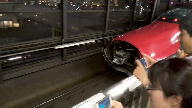 |
I call your attention to Exhibit A. In this captured frame from a video I’m recording, among the dozen or so of us spectators (well, specifically, tori-tetsu: those who like to photograph the trains) watching the uncoupling process, you’ll notice a woman also filming the mechanics of the two trains uncoupling. I should point out that this procedure is something that the uninterested would compare to paint drying: the elapsed time from when the combined train pulls in to the the Akita shinkansen pulling away here is several minutes, with only brief periods of activity during this time. (Much of the procedure goes unseen within the coupled cabs.)
In short: otaku find this interesting; non-otaku, well, not so much. (Ask my wife...)
| Exhibit B |
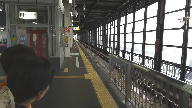 |
Let’s go on, shall we? May it please the court, I present Exhibit B. In it, we see an E6 approaching. (Well, maybe not yet: this is the first few seconds of the clip, so the train is still at the other end of the station, washed out by the daylight.) But at this moment, we do see—in the foreground—a mother holding her young son up so he can see the the approaching train.
Awww, that’s sweet. Mommy holds up her kid so he can watch the choo-choo approach.
Except she’s as absorbed by its approach as he is. And this is no isolated instance. It’s prevalent enough that this category of otaku has a name, too: not surprisingly, mama-tetsu (and the kid is chibi-tetsu...)
Not convinced yet? I understand, sexy shinkansen, right? I mean, who wouldn’t stare at a Ferrari or Lotus pulling up?
Let’s head down to Tokyo, and in particular, the Enoden line. This is a “private” line (that is, not part of the JR system) and their rolling stock is... well, let’s just say, a whole lot less curvaceous.
Downright boxy, actually.
Ladies and Gentlemen of the Jury, let’s take a look here, at Exhibit C.
| Exhibit C |
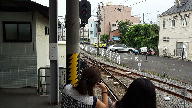 | 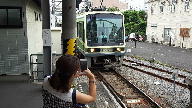 |
| At the start of the line, a couple of girls jump to the front of the platform to get a picture of the approaching 4-car train. You can barely make it out way off in the distance as it comes into view (it’s obscured by the pillar in the foreground and that pale blue building in the distance... see it? The girls sure do.) | One of the girls is still taking pictures as the decidedly boxy train pulls up to the platform. (Her partner in crime has ducked back into line behind us, to be sure they get good seats.) |
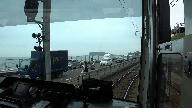 | 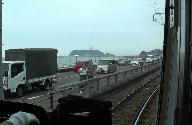 |
| Midway along the route we’re stuck in a passing siding waiting for the oncoming train to clear the track ahead. While we’re there, a girl and her boyfriend ramble up; she has him take a picture of herself in front of the train... | ...before taking one of her own photos. The boyfriend seems disinterested (they didn’t swap places for her to take a picture of him, nor did they do a selfie together) so it’s pretty clear which one is the otaku. |
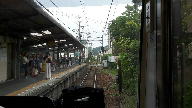 | 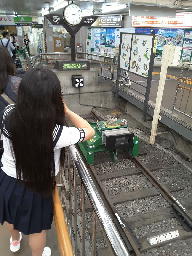 |
Along the line, we see this woman (in the white slacks) filming the train’s approach.
Wait, Thomas, isn’t she just a Digital Zombie?
No, she’s standing on the yellow strip, something the station staff are pretty good about shooing you off from if you’re just standing there inattentively playing Pokemon Go or Crystal Crush. |
| Finally, at the end of the line, a school girl hurries to get a photo of the Enoden mascot, a frog placed on the bumper. |
| Exhibit D |
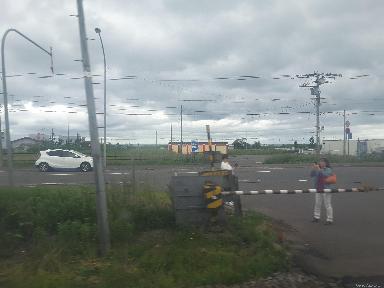 |
| Two women are seen in Hokkaido photographing the passing KiHa 283 Super Hokuto I’m on. The location is the fairly remote from a tourist’s standpoint, thus it takes some dedication to get here, so not just a “hey, look, a train is coming!” opportunistic shot on their part. This is another photobomb in a way, since I was photographing an arbitrary crossing gate for modeling purposes, and they happened to be there. |
Hopefully I’ve presented enough information to convince you that female railfans are quite abundant, and quite unabashed about being so. I didn’t go out of my way to take these photos. In fact, some (like the school girl) were inadvertent photo-bombs. But most were just there, and were caught in frame while I myself was being rather, um, otaku.
In short, they’re out there, and in significant numbers.
Why? The reason is quite obvious: like their male counterparts, they think trains are cool.
And this demographic is being catered to, as well. There are manga and anime series about trains—from a woman’s perspective—and even a production like NHK’s Japan Railway Journal has female guests to report on railway developments. Guests like actresses Miki Murai, Rena Matsui, Rei Kitada, and Jessica Claros; fashion model Saya Ichikawa, photographer Naomi Yano, TV personality (and former JR employee) Atsumi Furuya are all recognized rail enthusiasts.
Update 2021: As of this update, the newest host of JRJ is youtuber, model, TV personality and fellow Müchener
Cathy Cat. Emphasis here is on
host—the position previously held by Nathan Berry, and Russell Totten before him—not just occasional
guest tarento. Ausgetzeichnet, Cathy; beste glückwünsche.
The message? Not only are the trains cool, but it’s cool to be a railfan... and no less so if you’re female.
| Tetsudo Otaku Retail |
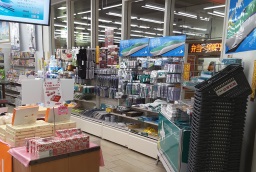 |
| Retailers are not shy about selling train-themed goods. The picture above shows several meters of shelf space devoted to such items... at the entrance of a convenience store, no less. In fact, only the island in the left foreground, and the books above it at the left edge are not train-related. The cooler at right sells ekiben: bento boxes, including train-themed ones (below) for you to take onto the train with you. |
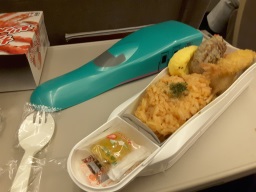 |
Guy or girl, merchants are happy to accommodate your fix... even if taking pictures isn’t “your thing.” Go to nearly any convenience store, especially in or near a station, and you’ll find several aisle-feet of train-related merchandise. Common items include train-themed wallets, key-chain fobs, photo (and ticket) holders, datebooks and calendars, socks, toothbrushes and combs, refrigerator magnets, bento boxes (both ekiben and just the boxes for you to put your lunch into), cups and mugs, chopsticks and other utensils, face-cloths and tissues, cosmetic boxes, and more. This isn’t just tourist chotchkies, but daily-use items, too.
(You got that, right? Face-cloths. Tissues. Cosmetic boxes. This is not just “guy” stuff.)
So if you go to Japan and fall in love with the trains—which is quite easy to do—don’t feel ashamed, even especially if you’re a girl. If anything, join the crowd: you’re in good company.
Sections: 4
Otaku?
— Thomas M. Tuerke
I know, I know: in Japanese, otaku has the meaning very much like geek or nerd... and that’s still fairly prevalent in mainstream society.
But go to Akihabara, and you’ll find cosplay otaku, manga otaku, figure (doll) otaku, robot otaku, military otaku, and so on. Many wear the label otaku as a badge of honor. This “ownership” of the term is gradually changing minds, so while tetsudo otaku may literally mean train geek, it’s not so stigmatized anymore. There’s a growing geek-chic associated with it. And, of course, with many celebrities “coming out” as tetsudo otaku themselves, it’s not considered a social blemish to self-identify as one.
So take ownership, and feel free to be otaku...
Sections: 2
Tetsudo? Densha? Ressha?
— Thomas M. Tuerke
So, what term to use?
Heretofore, I’ve been using the term tetsudo otaku. Others apparently use densha otaku. Which is right?
Well, both are. Or at least, neither is wrong.
Tetsu (鉄) means iron, thus tetsudo (鉄道, literally “iron road") means railway. So this is the umbrella term.
Den (電) means electric so densha (電車) implies a vehicle powered by electricity. Given the abundance of electrically powered trains in Japan—very few railways aren’t electrified—this is accurate, and quite commonly used, but not as encompassing as tetsudo. Ressha (列車) is the term for diesel powered rail vehicles, but for historical reasons has continued to also generally mean “train”. While the designation “SL” (for Steam Locomotive, seemingly) is used, even for the enthusiasts (eg SL-tetsu), the term kisha (汽車, literally “steam vehicle") refers to steam trains.
Yeah, I’m aware of the pedants who will argue that many diesel locomotives are technically diesel-electrics but that is getting a bit hyper-pedantic. Also, Japan’s diesel rolling stock is chiefly diesel-hydraulic, so the diesel-electric argument is generally moot. For the sake of discussion here, if a vehicle doesn’t store its own energy source but instead gets its power from a pantograph, consider it electric, so densha, whereas if it burns diesel to turn the wheels, it’s a ressha. I’ll point the pedants to inspect a DE10 (Diesel-hydraulic 5-axle locomotive) versus an EF200 (Electric 6-axle locomotive)
So to sum up, using the term densha otaku you’ll definitely be understood, and even ressha otaku won’t have people look at you askance, but understand the implied categorization, even if you’re not aiming for that specifically. However, tetsudo otaku is an undiscriminating all-around train nerd.
And a final addendum: it’s te-tsu-do. Be careful: tes-tu-do is the latin term for a shield formation where roman soldiers enclosed themselves in a shield wall. Completely different thing. ;-]
Female Tetsudo Otaku
— Thomas M. Tuerke
Another addendum: women enthusiasts are also known as tetsuko.
Real Rail Role Model
— Thomas M. Tuerke
One realistic explanation for female interest in rails is, no doubt, the career opportunity. According to 2014 salary reports, the money is pretty good.
Say what you will, this is not menial work, and women do it. In these two frames from video I took, we see the conductor of an E5 supervise the coupling of an E6 in Morioka station. A female conductor, just in case it wasn’t evident.
| Female Conductor Calling the Shots |
| Much of shinkansen operations is governed by central control, but for the finesse required to perform this coupling, somebody needs to be at the scene. This is done by the conductor of the forward train, since the driver of that train is a quarter-mile away, and the driver of the approaching trail, obviously, is busy driving that train. |
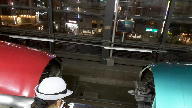 | 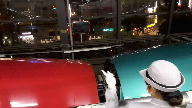 |
| Here, the conductor—radio in hand—has overseen the call-on which allows the red E6 to approach the teal E5. | Coupling complete, the conductor is seen doing the shisa-kanko (point and call) procedure as part of the post-coupling checklist. |
While the smartly-dressed conductor is somewhat of a trope, women are also seen in the “driver’s seat” as well, as these videos will attest. Local trains, express trains, even shinkansen are driven by women. Here we see a driver crew change at Shin-Osaka station (handover between JR West and JR Central, note the different uniforms): relief driver waits for train to approach; relieved driver emerges and both salute each other; relieved driver reports status of train; new driver takes over, and the train pulls out. Yes, the woman you saw is driving the quarter-mile long 16-car N700 shinkansen. Just in case you need more proof, another shinkansen driver shows this is no oddity.
(And being a conductor is not just a “girl thing”, either.)
So running “twelve-inch-to-the-foot” trains is no more of a “guy” thing than being otaku about them. No wonder the interest in trains is “equal opportunity”.
Update: Here’s another example, with a crew change on the iconic Series 500 Shinkansen. Note that the replacement crew consists of two people, but the woman is clearly the higher ranking employee: she steps forward for the hand-over, and later she is seen in the driver’s seat in the cab. Yes, there is a lot of saluting... the military precision with which rail employees do their job is part of the reason the service is so good.
In this Japanese game-show/documentary on Doctor Yellow, the diagnostic train JR uses to keep the Shinkansen right-of-way running in prime condition, we see a couple of things: the many female otaku on the platform when the elusive Doctor Yellow passes through a station, as well as the female driver at a shift hand-over.
Sections: 1
More Links:
— Thomas M. Tuerke
Here are some links of real rail women, whether they are drivers or enthusiasts:
TV shows:
Rail Enthusiast Momo Ito visits the JR Inn Hakodate special Train Room, that is to say, a room with railcar appointments including a Kiha 40 cab simulator...
Note: these links do have English subtitles, and online translators do a good job of translating the on-page text, so those not quite up on their Nihongo: don’t be shy.
For Real...
— Thomas M. Tuerke
Yes, girls are also involved in the hobby. One case in point, Suzukawa Ayako posts videos on Youtube covering her explorations of train-related things. In a few instances, Ms Suzukawa (who “likes transportation mainly such as railroads") explores a Mall’s Train-themed Store (including renting the layout to run her model train) and also visits Tomix World where she works on a small diorama module. And more fun too.
Kids get into the train thing, too.
Pretty in Pink
— Thomas M. Tuerke
After the original Series 0 Shinkansen (with the round nose profile that gave it the Bullet Train moniker) the next most recognizable is the Series 500, looking more like a jet than a train.
While superseded by the Series N700, the Series 500 continues to ride on its highly recognizable shape, frequently put into service as a specialty train. It’s fairly common for popular trains to sport a special livery, and the Series 500 has done that on numerous occasions.
Most recently, the livery has taken a decidedly rosy tint inside and out, themed as the Hello Kitty Shinkansen, and it’s making quite a buzz.
In other words, Pure Kawaii.
It’s pretty clear that the target demographic is young girls, plus the women that have grown up with the iconic feline over the last half century. While there is a non-trivial male contingent of Kitty White admirers, they are a clear minority.
Being neither purely utilitarian transport, nor seeking male-only admiration, Japanese Trains such as the Shinkansen—being so tightly integrated in the day-to-day lives of so many Japanese men and women alike—continue to be objects of mutual appeal: both men and women are attracted to these cool trains. And, of course, this extends to the toy and hobby space as well, where pink unabashedly joins blue as a highly sought-after livery.


















 Generate a QR code link to this page
Generate a QR code link to this page